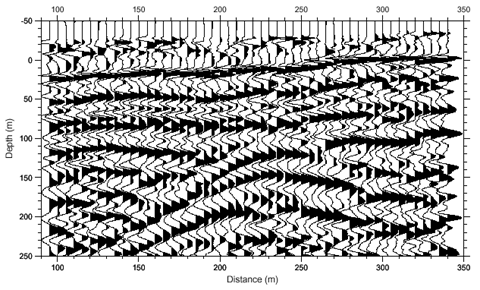
SEG Y
Encyclopedia

File format
A file format is a particular way that information is encoded for storage in a computer file.Since a disk drive, or indeed any computer storage, can store only bits, the computer must have some way of converting information to 0s and 1s and vice-versa. There are different kinds of formats for...
is one of several standards developed by the Society of Exploration Geophysicists
Society of Exploration Geophysicists
The Society of Exploration Geophysicists is a nonprofit organization dedicated to promoting the science of geophysics and the education of exploration geophysicists. The Society fosters the expert and ethical practice of geophysics in the exploration and development of natural resources, in...
for storing geophysical
Geophysics
Geophysics is the physics of the Earth and its environment in space; also the study of the Earth using quantitative physical methods. The term geophysics sometimes refers only to the geological applications: Earth's shape; its gravitational and magnetic fields; its internal structure and...
data. It is an open standard
Open standard
An open standard is a standard that is publicly available and has various rights to use associated with it, and may also have various properties of how it was designed . There is no single definition and interpretations vary with usage....
, and is controlled by the SEG Technical Standards Committee, a non-profit organization.
The format was originally developed in 1973 to store single-line seismic digital data on magnetic tape
Magnetic tape
Magnetic tape is a medium for magnetic recording, made of a thin magnetizable coating on a long, narrow strip of plastic. It was developed in Germany, based on magnetic wire recording. Devices that record and play back audio and video using magnetic tape are tape recorders and video tape recorders...
s. The specification was published in 1975, and has since been named as the rev 0 specification. However, since its release, there have been significant advancements in geophysical data acquisition, such as 3-dimensional seismic techniques and high speed, high capacity recording.
The most recent revision of the SEG Y format was published in 2002, named the rev 1 specification. It still features certain legacies
Legacy system
A legacy system is an old method, technology, computer system, or application program that continues to be used, typically because it still functions for the users' needs, even though newer technology or more efficient methods of performing a task are now available...
of the original format, such as an optional SEG Y tape label, the main 3200 byte
Byte
The byte is a unit of digital information in computing and telecommunications that most commonly consists of eight bits. Historically, a byte was the number of bits used to encode a single character of text in a computer and for this reason it is the basic addressable element in many computer...
textual EBCDIC
EBCDIC
Extended Binary Coded Decimal Interchange Code is an 8-bit character encoding used mainly on IBM mainframe and IBM midrange computer operating systems....
character encoded
Character encoding
A character encoding system consists of a code that pairs each character from a given repertoire with something else, such as a sequence of natural numbers, octets or electrical pulses, in order to facilitate the transmission of data through telecommunication networks or storage of text in...
tape header and a 400 byte binary header.

This image shows the byte stream structure of a SEG Y file, with the Revision 1. added Extended Textual File Header records.
Many SEG Y programs do not totally follow the specification. For example, ODEC uses the opposite byte order and adds 320 bytes to tail of each trace.

